Sailboats, also known as sailing boats or sail vessels, are watercraft that propel themselves through water by using sails to capture the wind. Some key facts about the history and definition of sailboats are:
Sailboats have been used for transportation and recreation for thousands of years. The earliest known depictions date back to Ancient Egypt and Mesopotamia around 3500 BC.
Over the centuries, sailors developed key rigging configurations like the catamaran, ketch, sloop, and schooner. Advances in materials also enabled multi-masted vessels like clippers and frigates.
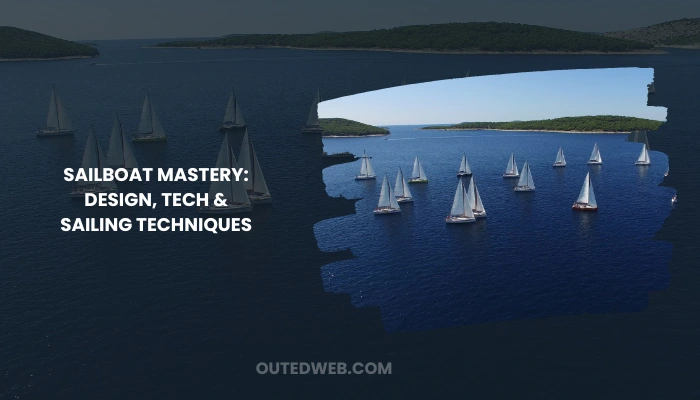
Today’s sailboats come in a variety of hull designs, from simple dinghies to large luxury yachts. Common hulls include monohulls, catamarans, and trimarans.
Sails capture the wind to form pressure gradients that propel the boat forward. Key parts include the mainsail, jib, spinnaker, and booms. Modern versions may incorporate foils and electric components.
Navigation relies on the apparent wind direction and speed measured from the boat. Key instruments include the compass, GPS, and wind indicators.
| Part | Description |
| Hull | A watertight body that floats the vessel |
| Keel | Underwater fin provide lateral resistance and stability |
| Mast | Vertical spar supporting the rigging and sails |
| Boom | The horizontal spar that the sail attaches to at the bottom |
| Rudder | Underwater plate controlling the direction of travel |
This article will provide a comprehensive overview of sailboat design, technology, and operation. Key sections will explore sailboat components, various rig configurations, propulsion principles, navigation techniques, and best practices for seamanship and maintenance. Upon reading, you will gain an in-depth understanding of how sailboats work and how to safely handle one on the water.
Sailboat Components
Alright mate, let’s talk sailboats! There are so many clever components that come together to make these wind-powered beauties sail. Strap in and I’ll dive into five key areas:
The Hull
Sailboat hulls come in different styles like monohulls, catamarans, and trimarans. Monohulls are the most common and have a single displacement hull. This provides good stability but can be slower. Many monohulls have a rounded hull shape called a “sump,” which helps the boat move efficiently through the water.
Catamarans have two parallel hulls connected by a deck and are known for their speed. Their pontoon-style hulls reduce wetted surface area and allow the boat to “plane” across the top of the water instead of displacing it. This makes catamarans excellent for performance sailing.
Trimarans have a main hull and two smaller outrigger hulls on each side. This three-hull design provides great stability, even in rough conditions. It also reduces drag for higher speeds. However, the complex multi-hull setup requires more expertise to handle.
In terms of materials, fiberglass, wood, and metals are popular choices. Fiberglass is lightweight and durable but more expensive. Wood is traditional but requires frequent maintenance. Metals like aluminum are robust but heavy. Overall, the hull shape and substance must provide buoyancy, control, and strength!
The Rigging
No discussion of rigging is complete without mentioning the all-important mast. This vertical spar stands tall and supports the entire weight of the standing and running rigging above. Strong aluminum or carbon fiber masts are commonly used.
Attached at the top of the mast are two rigid spars called booms that extend the mainsail and headsail out from the boat. Lines called halyards are used to raise the sails of the mast. Winches are then used to grind these lines tight.
An array of standing rigging, like shrouds and stays, connects the mast securely to the deck and hull. These cables and sheets of wire keep the powerful mast safely upright under the press of the sail. Finally, the brightly colored lexicon of sails themselves works to capture wind energy!
Together, the mast, booms, sails, and supporting rigging form an expertly crafted mechanism for propelling a boat using nothing but wind power. It truly is an elegant solution that has stood the test of time.
Deck Hardware
Winches are crucial deck hardware, helping sailors grind lines tight with mechanical advantage. Finely machined winch pawls grip lines securely. Nearby, clutches lock away extra lines under load to prevent tangles.
Cleats provide secure attachment points using integrated jaws that grip lines like a vice. Pulleys move wheel lines neatly through blocks to change direction with low friction. fairleaders guide lines neatly to sheaves without jamming.
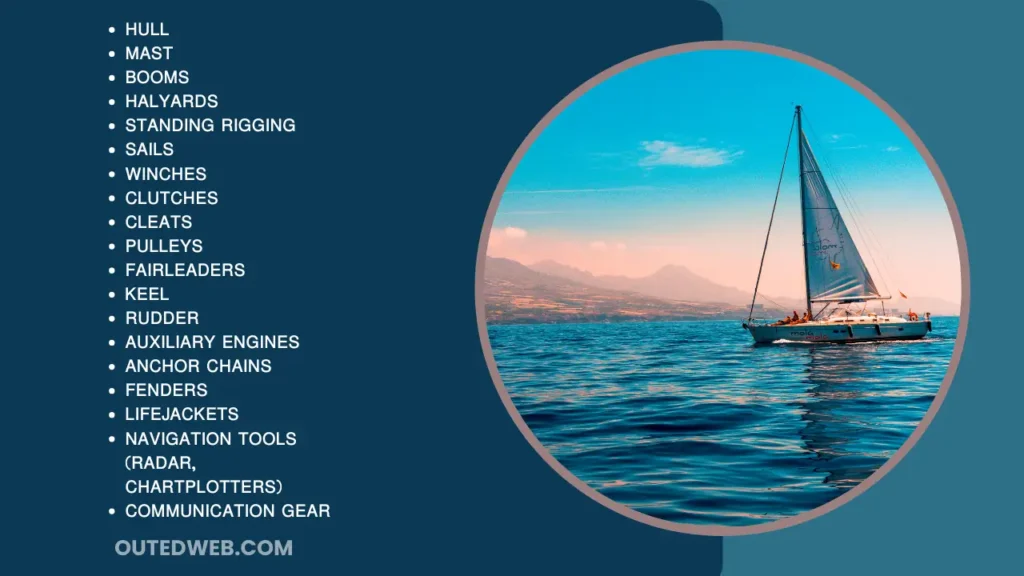
Hardware like these accept huge loads yet are often no larger than a fist. Quality components from brands like Harken offer smooth operation for decades in the harshest marine environment. Onboard systems simply wouldn’t function without their unsung efforts.
The Keel and Rudder
The keel is a virtually indispensable underwater element extending below the hull. It increases the righting moment to resist heeling and capsize. Deeper keels provide better tracking ability in waves too. Ballast keels integrate lead for stability, while fin and wing keels offer low-drag performance.
The rudder provides directional control via an underwater foil that steerers adjust from the accompanying rudderstock. Variants range from centerboards that lift entirely to stubby spade rudders. Together, the keel and rudder transform an unstable raft into a steerable vessel pointing ever toward the horizon!
Auxiliary Systems
While sail power remains king, auxiliary engines offer flexibility when conditions won’t cooperate. Small gas or diesel outboards are common but efficient electric motors are growing in popularity. Modern engines start with respectable torque, even in trying conditions.
Onboard sailors rely on a suite of fittings and hardware to secure everything from anchor chains to fenders and lifejackets. Electronic navigation tools help skippers decipher cloudy conditions with radar, chartplotters, and more. Communication gear keeps sailors in touch with shoreside operations.
Modern convenience has dramatically improved seakeeping safety and comfort over the years. Yet for all our technical prowess, nothing quite matches the simple elegance and enduring allure of a sailing vessel catching a fresh sea breeze under full canvas!
Sailboat Design
Sailboat design involves balancing performance, functionality, and safety. Engineers have devised ingenious solutions over centuries of development. Let’s explore some key elements of hull, rigging, and system configurations.
Hull Design
The underwater body that interfaces with water is fundamental. Monohulls like those seen at marinas worldwide remain dominant with a single flotation device. But for stability in rough conditions, multihull designs excel by widening the vessel’s footprint.
Catamarans spread weight across two narrow hulls connected by a bridge. Studies show their stability allows daring feats like solo ocean crossings. Other multihulls, like trimarans, add a third slender pontoon. By reducing reliance on ballast, both achieve impressive speeds.
However, extra hulls increase drag so lightweight structures are paramount. Modern versions embrace aluminum and carbon-fiber composites. Some pioneering models even float independent hull sections for modular assembly.
Keel Variations
Keels influence a boat’s tracking, carrying capacity, and shallow-water access. Deeper full keels and fin keels maximize lateral resistance but limit draft. Retractable centerboards or dagger boards offer the best of both worlds with a vertical lifting option.
Wing keels present an intriguing alternative with stable underwater “wings” offering good directional stability while raising the hull profile. Even more advanced alternatives include canting keels that rotate ballast bags port or starboard for enhanced upwind performance.
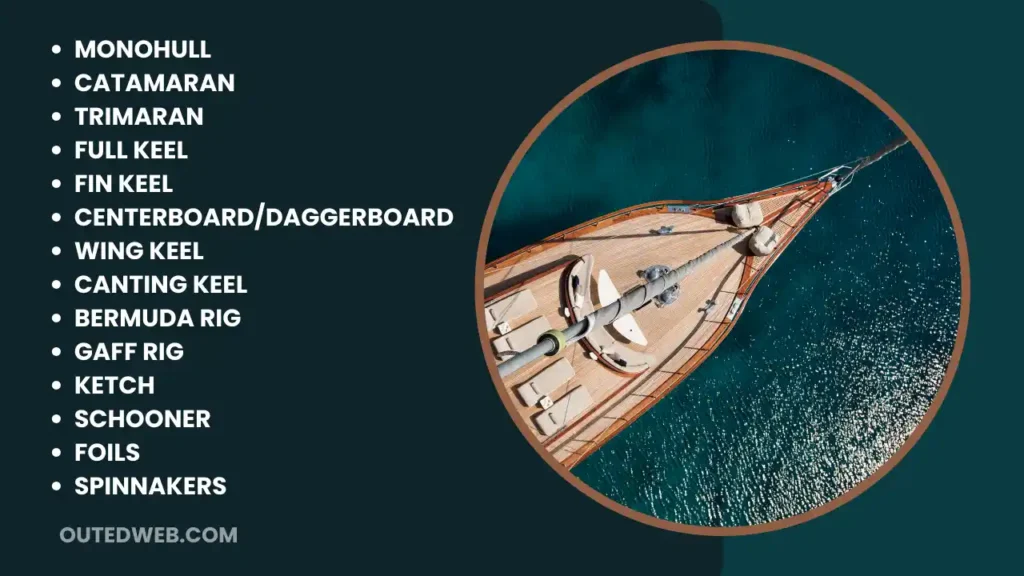
Rigging Technology
Sail plans vary tremendously in style and performance. The Bermuda rig predominates with triangular sails hung from a sloped mast. Gaff rigs furl four-sided canvas atop the mast. Multi-masted vessels like ketches and schooners gain added propulsion zones.
Foils and spinnakers capture maximum wind with distinctively shaped sails. Carbon fiber and hardware optimize strengths. Electronics automate functions from backstays to winches. Hydro-generation charges batteries for instrument arrays and electric motors as auxiliary thrust.
Miniaturized sensors and autopilots provide solo-sailor-assisted navigation even in big seas. Studies integrate AI with weather models to optimize long-distance passages. Drones scout conditions ahead and assist with docking maneuvers.
Ergonomics
Modern yacht designs cater to onboard living. Hull windows flood interiors with light. Forward cockpits expand social areas while protecting limbs in rough conditions. Underwater lighting entertains swimmers.
Belowdecks, commodious galleys, and stand-up headroom in showers have become standard. Additional berths and quiet diesel-electric systems suit family cruising. Raise-lower table mechanisms optimize indoor-outdoor flow. Cockpit refrigerators keep refreshments chilled at any time.
Functionality, efficiency, and safety rule in sailboat designs. May you enjoy fair winds and smooth sailing while exploring engineering excellence afloat!
Sailboat Systems and Technology
Mastery of engineering empowers sailboats to explore. Let’s survey integrated systems that transform wind power into seamanship.
Propulsion
The heart of any sailboat is its propulsion. Unlike engines, sails capture kinetic energy from the wind via complex aerodynamic interactions.
As boats move through water, apparent wind—the vector sum of true wind and boat speed—determines pressure gradients impacting sail shape. Through millennia, sailors honed designs balancing form and function.
Today, computational fluid dynamics simulates intricate airflow patterns. The new sailcloth blends high-strength fibers for optimal tensioning. Boats calibrate rig setups factoring diverse conditions.
On-water instrumentation precisely measures true wind, boat speed, and their resultant apparent wind. Such instrument arrays provide crucial real-time propulsion insights for advanced maneuvering.
Hybridizations integrate auxiliary electric drives positioned to augment—not replace—wind propulsion. Trials optimize placement and control for performance boosts without detrimentally impacting efficiency. On extended missions, hydro-generators charge onboard batteries using hydrokinetic energy.
Navigation
Autonomous navigation commences by establishing a reference coordinate system with magnetic, true, and grid north distinctions. Global Positioning Systems pinpoint latitude and longitude with meter accuracy. Modern autopilots automatically maintain preset courses.
Vessel identification and monitoring systems automatically recognize nearby traffic. Anemometers quantify wind angles. The wind vanes visually display the heading. Multi-parameter instrument displays consolidate crucial parameters. Depth sounders scan underwater terrain.
Sensors network through integrated circuits, transmitting observations wirelessly for centralized processing. Scientific arrays self-calibrate and transmit data non-stop for extended durations. Captains oversee voyages through tablet interfaces, accessing weather, currents, and scholarly discoveries.
Instrumentation
Autonomous arrays now integrate miniature, intelligent sensors. Nutrient analyzers quantify phosphate and nitrate. Salinity and dissolved oxygen monitor the profiles of the water layers. Thermometers profile temperature distributions. Undersea camera arrays facilitate spatial observations and object detection.
Today’s miniaturized smart sensors communicate wirelessly. They form underwater observation networks through integrated circuits. Scientific containers house calibrated equipment suites, transmitting observations continuously for weeks unmanned.
This networked instrumentation benefits broad research themes, from changing biogeochemistry to shifting boundary currents, with high-resolution datasets transmitted across vast distances. High-power computing processes growing volumes of real-time environmental intelligence.
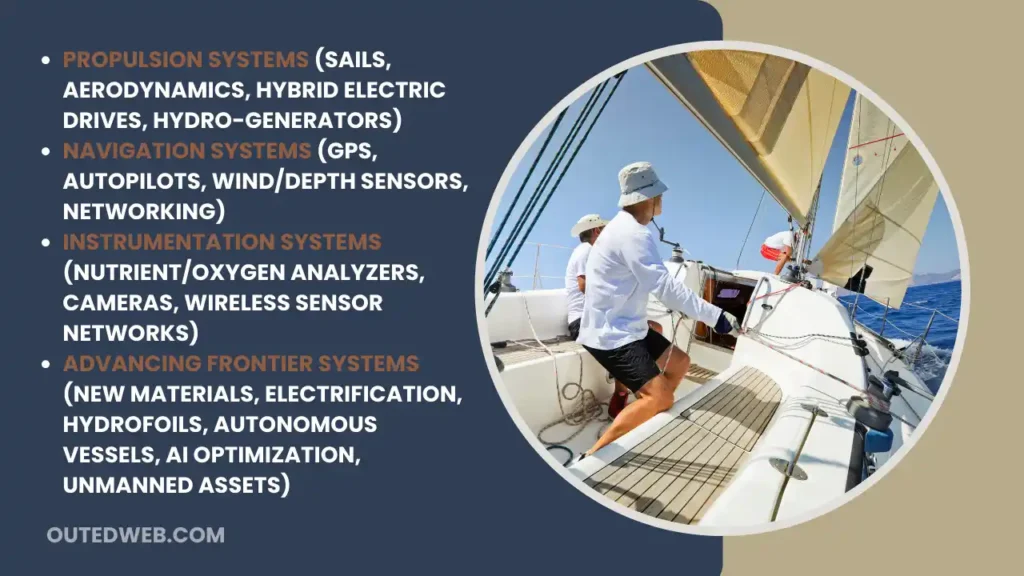
Advancing the Frontier
Studies explore applying engineering across disciplines. Hull designs embrace new composites. Systems embrace electrified efficiency and hybridization. Intelligent hydrofoils radically transform performance.
Unmanned platforms conduct remote observation. Autonomous vessels self-assemble modular construction optimized for scientific duty. Distributed sensor networks inform ecosystem changes at unprecedented scales and resolutions.
Artificial intelligence optimizes long-term mission planning factoring unforecast conditions through experience. Unmanned assets assist with tasks ranging from infrastructure inspection to virtual mooring networks. Together, innovative thinking and rigorous engineering make sail technology a powerful ally for ocean study.
Sailing Technique and Seamanship
Let us explore the art of sailing by discussing controls, maneuvers, and prudent practices. Knowing techniques empowers seafarers to handle vessels smoothly in harmony with nature’s forces.
Sail Trim and Boat Balance
The aerodynamic forces acting on sails are key to propulsion. A sail’s shape depends on wind pressures across its surface.
As boats move through water, apparent wind arises from the vector sum of true wind and boat speed. Its pressure gradients dictate sail shapes.
Craft meticulously calibrated rig dimensions and cloth qualities. Computational fluid dynamics simulates sail airflow in complex detail.
On-water instrumentation precisely tracks true wind, boat speed, and their resultant apparent wind, enabling advanced sail control.
Crews map voltages from masthead instrumentation across wind angles. Novice sailors’ reference compasses are relative to the grid north.
Balance also influences how readily a heel can be crafted. Proper weighting distribution and crew positioning ensure both performance and steadiness in varying conditions.
Experts master tradeoffs between power and stability through extensive refinement. Control tweaks integrate interactive influences for peak speed while maintaining control.
Tacking and Gybing
Turning through the wind employs two maneuvers: bearing away heads and then luffing forward or vice versa. Interlaced execution prevents mishaps.
Reaching downwind, gybing involves ducking the boom across as sails swap sides. Expert timing forestalls damage and injury.
Novices repeatedly practice evolutions to refine teamwork under diverse conditions. Masters enforce strict adherence for safety.
Navigation lights distinguish vessel types visually after dusk. Fog signals aid low-visibility obstacle avoidance through mists or fogs.
Regulations internationally legislate “stand-on” and “give-way” vessel priorities. Courses mutually adjust when converging using audible or visual signaling in hours of darkness.
Restricted waters dictate extra vigilance within defined bounds. Crews commit traffic rules through demonstration and rote practice. Masters strictly enforce regulations.
Anchoring and Mooring
Anchors temporarily attach to bottom sediments using flukes that dig in. Scope ratios correlate tackle lengths to depths.
Buoy moorings fix vessels at designated spots through hull-pendant-buoy systems. Their pickup prevents groundings in crowded ports.
Studying scope ratios, swinging circles based on patterns, tackling properties for varying sediments, and mastering anchoring fundamentals.
Securing offshore demands requires accounting for forecast conditions like impending blows. Crews drop two anchors from the bow and stern diagonally, setting primary and backup “insurance” anchors.
Masters emphasize thorough preparation. Novice crews practice deployments to refine techniques for handling chains and ropes under guidance. Trials emphasize observation, and learning from each other, as working as an integrated team is crucial.
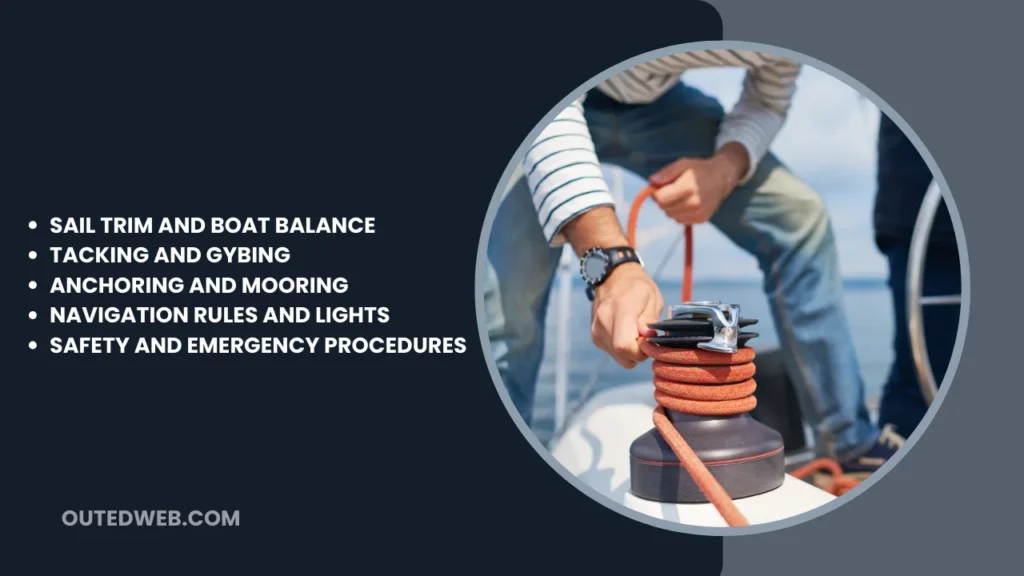
Rules of the Road
Rules standardized worldwide prevent collisions. “Stand-on” and “give-way” vessels designate right-of-way depending on position and course. Sailboats generally yield power-driven vessels.
On converging courses, “give-way” craft maneuver early to avoid the “stand-on” vessel’s path. When on single lines of bearings, the craft agrees to alterations in steering and sail trim using audible and visual signals after dark.
Restricted waterways require heightened attention within defined boundaries. Crews memorize traffic conventions, emphasizing avoiding risk through drills. Masters enforce strict compliance for the safety of all.
At night, navigation lights clearly distinguish vessel categories from every angle. Sound signals assist low-visibility navigation in fog or darkness. Charts demarcate regulated areas.
Safety and Emergency Procedures
Skilled crews constantly monitor changing conditions. Personal protective equipment like lifejackets stand ready whenever underway. Planning accounts for weather, including seasonal patterns.
Regular maintenance checks systems and stowage ensure readiness. Strict enforcement of safety regulations includes verified monitoring of onboard conditions. Masters hold absolute authority over vessel and crew welfare.
Crew conduct periodic drills responding to hypothetical emergencies to prevent mishaps. Constant watch-keeping remains key to all craft.
Choosing and Maintaining a Sailboat
Alright friend, are you ready to learn about choosing and maintaining your very own sailboat? This is one of the most rewarding parts of the sailing journey. Whether you’re a first-time buyer or a seasoned sailor, there’s always more to learn when it comes to selecting the perfect boat.
Factors to Consider When Buying A Sailboat
Build quality, outfitting, and size suit needs. Options include daysailers, cruisers, or bluewater vessels. Designs balance performance, comfort, and economy.
Hull construction decides integrity. Epoxy composites excel but wood charms. Age and usage history merit vetting. Interiors balance function and appearance.
Mechanisms like self-tailing winches streamline line handling. Instrument arrays consolidate data. Electrical, plumbing, and tankage underpin convenience.
Berths and private facilities prioritize comfort. Storage optimizes gear stowage. Auxiliary power extends missions or tows from calms. All aspects influence value retention over lifespan.
Docking and Winterizing of Sailboat
Secure moorings accommodate diverse conditions. Proficiency in lifting, lowering, and tying permits self-reliance. Deck arrangements affect ground access convenience.
Professional or self-performed rig and machinery winterization prevents damage. Cosmetic considerations like teak preservation maintain buyer appeal.
Time invested in caring translates directly to future enjoyment and resale potential. Yard work supports long-term affordability, avoiding costly repairs due to neglect.
Repair and Upkeep
Scheduled maintenance identifies small issues before they worsen. Systematic inspections uncover component life expectancies, load histories, and impacts.
Planned restoration maintains engineering and aesthetics. Specialized contractors address structural or mechanical intricacies.
Do-it-yourselfers gain confidence through incremental undertakings. Online communities foster skill-sharing and problem-solving.
Vigilance preserves equipment value and ensures safety offshore. Responsible diligence ensures pride of ownership for years.
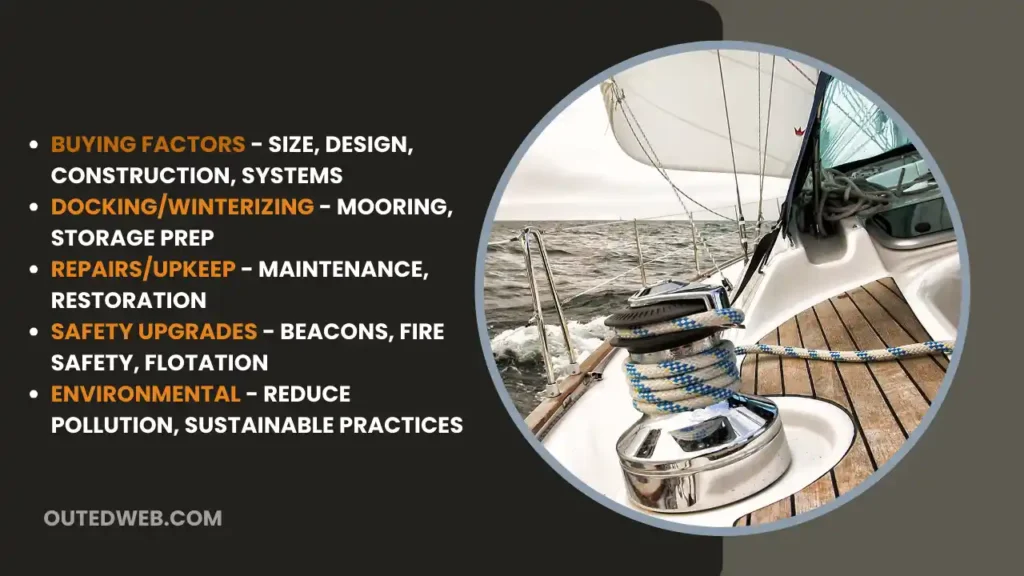
Safety Upgrades
Advancements continually strengthen protections. Personal Locator Beacons automatically summon rescuers. AIS transponders automatically track vessels.
Fire suppression systems douse electrical and fuel-fed blazes. Non-slip surfaces and strong points reduce strain and slips.
Cutting flotation into cabin structures enhances buoyancy and safety margins. Electronic monitoring accesses vessel conditions remotely.
Crews stay current through drills, responding to scenarios, and identifying areas for continuous improvement by referencing shared experiences.
Environmental Stewardship
Conscientious mariners curb non-biodegradable waste, containment spills, and noise and light pollution. Careful dockside practices avoid contamination.
Alternative energy options bypass fossil fuels. Programs endorse minimally-toxic anti-foulings and treatments. Education promotes sustainability through generations of seafarers.
Cruising Destinations
Are you getting the wandering spirit yet? When it comes to cruising destinations, sailors are truly blessed to have such a vast world waiting to be explored.
Whether you dream of multi-month ocean crossings or weekend jaunts to nearby islands, our big blue planet has so many amazing places to discover by boat.
Let’s start with some of the most popular sailing regions. The Caribbean tops many lists with its turquoise waters and lush landscapes. Here, you can island hop between countries like Cuba, St. Martin, and the Bahamas all season long.
Across the Atlantic, the Mediterranean beckons, with over 20 countries to cruise between. The azure seas surrounding places such as Croatia, Italy, and Greece call out to sailors.
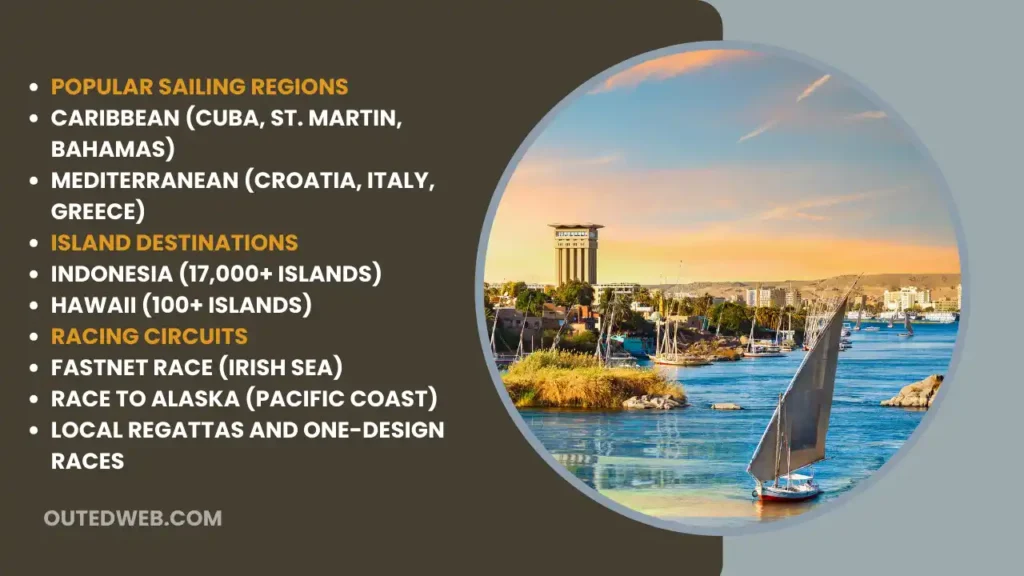
For those seeking an island escapade, planning your custom itinerary can lead to unforgettable experiences. In places like Indonesia, you can spend weeks charting a course through the over 17,000 islands spanning across the archipelago.
Another superb island route is hopscotching between the over 100 islands that make up the Hawaiian chain. Just remember to keep an eye on the weather!
Let’s not forget the hard-core racing circuits that attract top competitors and spectators alike. Events like the Fastnet Race test sailors’ grit as they battle the unpredictable Irish Sea.
For multihull aficionados, the Race to Alaska allows crews to channel their inner explorer while racing up the Pacific Coast. On a smaller scale, most summers welcome a steady schedule of regattas and one-design races close to home as well.
Frequently Asked Questions
Those curious about sailing often wonder:
How Difficult Is It to Learn the Basics of Sailing?
With proper instruction and practice, competent handling develops gradually for most. Repetition builds an understanding of vessel dynamics.
What Certifications Are Required for Sailing?
Locally, minimal qualifications may exist. However, seafarers typically obtain certifications demonstrating sailing and safety mastery.
Which Sailboat Types Suit Beginners?
Small-day sailers or catboats that provide stability and simplicity work well. Larger cruising vessels necessitate crew familiarization before going offshore.
How Much Does Sailboat Ownership Cost?
Initial pricing varies widely. Maintenance like scheduled upgrades, winterization, and docking also factor into yearly budgets. Insurance, storage, or association fees further commitment.
How Many People Can a Sailboat Accommodate?
Capacities range from solos to sizable vessels sleeping a dozen or more, depending on size and layout. Crew numbers influence handling.
What Safety Gear Must One Carry for Sailing?
Regulations mandate lifejackets, flares, and radio-based craft lengths. Skilled crews prepare beyond the minimum by practicing emergency drills.
How Fast Do Sailboats Travel?
Speeds vary depending on conditions and hull designs. Keel and rig types impact upwind abilities. Racing configurations maximize velocities.
Can Sailboats Progress Into the Wind?
Yes, by “tacking” and “gybing” alternating sides through the blowing direction in a zigzag pattern.
What Major Sailing Events Exist?
World-famous competitions include the America’s Cup, the Volvo Ocean Race, and the Olympic Games. Local regattas welcome all skill levels.
Final Verdict
Sailing vessels showcase humankind’s enduring relationship with wind and waves. Through a constantly deepening understanding of aerodynamics, structures, and seamanship, dedicated sailors continuously refine wind-driven maritime transport.
Today’s autonomous robotic sailboats look set to advance integrated skill sets from the classroom to the open ocean. Their proven long-range clean energy promises to expand contributions to marine research, promoting environmental understanding.
Judicious safety stewardship across maritime disciplines will ensure sailing serves generations to come as a source of adventure, commerce, and scientific progress worldwide.

